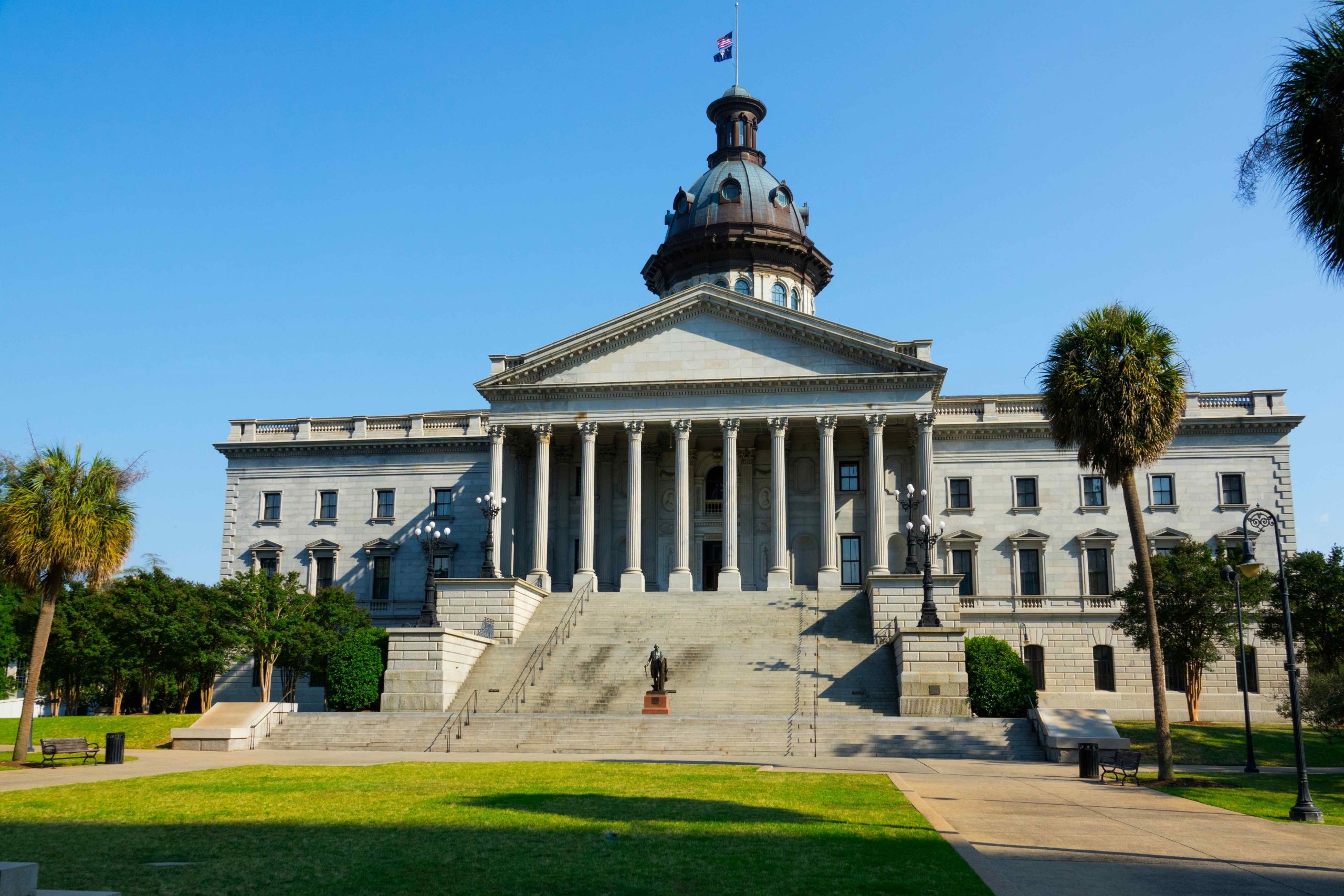Mandatory minimums, payday lending, and voting rights in first session of Supreme Court term
SESSION PREVIEW
on Sep 29, 2023
at 4:04 pm
The South Carolina State House where Republican legislators enacted a redistricting plan that will come before the Supreme Court on Oct. 11. (Dennis MacDonald via Shutterstock)
The Supreme Court will kick off its 2023-24 term on the traditional first Monday in October. The court’s October argument session will feature six arguments over five days, on topics ranging from federal sentencing laws to voting rights. And although the court did not make an official announcement, its website indicates that it plans to continue to provide live audio of oral arguments this term, allowing anyone interested in a case to listen from home.
The justices begin the new term with a dive into the weeds of statutory interpretation in Pulsifer v. United States, a case involving federal sentencing laws that – at least according to the defendant – turns on whether the word “and” in the federal law at issue means “and” or instead “or.”
The defendant in the case, Mark Pulsifer, pleaded guilty to one count of distributing at least 50 grams of methamphetamine. Because of a prior conviction, Pulsifer would normally face a mandatory minimum sentence of 15 years. In the First Step Act of 2018, however, Congress created a “safety valve” to give judges discretion to impose lighter sentences for defendants who meet certain criteria – specifically, a defendant who does not have (A) more than four “criminal history points,” (B) one kind of prior offense, and (C) a second kind of prior offense.
The question in Pulsifer’s case is how to determine when those criteria are met, so that the “safety valve” – and therefore the possibility of a lighter sentence – applies. Pulsifer had more than four criminal history points (A) and had been convicted of the kind of offense specified in (B), but he had not been convicted of the kind of offense specified in (C). He argues that the “safety valve” therefore applies because he has two of the “indicators” that can disqualify someone from relief, but not all three. But the lower courts ruled, and the federal government contends, that the “safety value” is only available to defendants who do not have any of the indicators.
Although the issue is a highly technical one, it is also one with significant real-world implications. One “friend of the court” brief filed in support of Pulsifer tells the justices that the lower court’s ruling “turns the statute on its head by foreclosing safety-valve relief for the vast majority of defendants to whom the statutory amendment might apply.”
Three-and-a-half years after the court heard oral argument in a challenge to the leadership structure of the Consumer Financial Protection Bureau, the justices will hear oral argument in a challenge to the agency’s funding mechanism. Perhaps the highest-profile case of the October argument session, Consumer Financial Protection Bureau v. Community Financial Services Association (covered in more detail in this preview) is also the first of several cases this term involving the division of authority between the three branches of government, as well as the power of administrative agencies.
The case began as a challenge to a 2017 “payday lending” rule that bars lenders from making multiple efforts to withdraw a repayment from a borrower’s bank account, causing the borrower to rack up additional penalties and fees when she does not have enough money in her account to cover the repayment. A three-judge panel of the U.S. Court of Appeals for the 5th Circuit rejected a challenge by payday lending groups to the substance of the rule. However, it agreed with the groups that the CPFB’s funding structure violates the Constitution’s appropriations clause – which instructs that “[n]o money shall be withdrawn from the Treasury, but in Consequence of Appropriations made by Law” – because the agency’s funding comes from the Federal Reserve, rather than through the normal congressional appropriations process.
If the justices agree with the court of appeals that the funding mechanism is unconstitutional, they will also have to decide what the remedy is for that violation. The CFPB contends that at most, the court should instruct the agency not to enforce the payday-lending rule against the challengers and their members until Congress provides funding for the CFPB through the normal appropriations process. A broader ruling, the CFPB and its supporters suggest, could call into question other actions taken by the CFPB, which could be very disruptive. But the challengers counter that the funding mechanism is so flawed that none of it can be saved. Only Congress, they argue, can fix the problem.
The argument will be a true battle of the titans for a separate reason. U.S. Solicitor General Elizabeth Prelogar will argue on behalf of the CFPB. She will face off against her predecessor, former Solicitor General Noel Francisco, representing the industry groups.
In Acheson Hotels v. Laufer, the justices will consider when a self-appointed civil rights “tester” has a legal right to bring a lawsuit under the Americans with Disabilities Act. The tester, Deborah Laufer, has physical disabilities and vision impairments. She filed a lawsuit in federal court in Maine, alleging that the website for an inn operated by Acheson Hotels violated the ADA because it did not contain enough information about the inn’s accommodations for people with disabilities.
The district court dismissed Laufer’s lawsuit, holding that she did not have a legal right to sue – known as standing – because she had no plans to visit the hotel and therefore was not injured by the lack of information on the website. After a federal appeals court reinstated Laufer’s lawsuit, Acheson went to the Supreme Court, which agreed in March to weigh in on whether Laufer can sue.
The case has drawn widespread interest. On one side, supporting Acheson, groups like the Retail Litigation Center warn that unless the Supreme Court intervenes, “serial litigants” like Laufer – who has personally been a plaintiff in more than 600 lawsuits – “will keep exploiting the ADA to force settlements from businesses, and clog federal court dockets, with meritless and bad-faith lawsuits.” But civil rights groups push back, arguing that the harm to an individual’s dignity from “personally experiencing discrimination in a place of public accommodation suffices” to provide standing.
In an unusual twist, however, Laufer – who in February had agreed that the justices should grant review – asked the court in July to dismiss the case. Laufer told the justices that she had voluntarily dismissed her case in the district court after Tristan Gillespie, an attorney who has represented her in other ADA cases, was disciplined by a federal court in Maryland. Laufer said that she did not want the allegations against Gillespie, who was not involved in the case now before the court, to become a distraction, but lawyers for Acheson urged the justices to go ahead and decide the case, telling them that they “should not pull the rug out from under” the company “when it is on the cusp of its day in this Court.”
In a brief unsigned order in early August, the justices rejected Laufer’s request to dismiss the case, but left open the possibility that they could still consider whether there is a live controversy in the case at the October argument.
The court is in recess on Monday, Oct. 9 for the federal holiday. The justices return to the bench and to statutory interpretation on Oct. 10 in Murray v. UBS Securities. The plaintiff in the case, Trevor Murray, filed a lawsuit against his former employer, UBS Securities, alleging that the company had fired him after he reported that he had been pressured to skew his research to support the company’s business strategies, in violation of SEC regulations. He relied on a provision of the Sarbanes-Oxley Act of 2002, which bars publicly traded companies from retaliating against employees who report violations of federal securities laws and regulations.
A jury awarded Murray nearly $1 million, but a federal appeals court threw out that award and sent the case back for a new trial. It held that because the Sarbanes-Oxley Act bars companies like UBS from taking adverse employment actions to “discriminate against an employee … because of” that employee’s whistleblowing efforts, the district court should have required Murray to show that UBS had fired him because it had intended to retaliate against him.
In the Supreme Court, Murray contends that the court of appeals got it wrong. The Sarbanes-Oxley Act, he says, incorporates the framework Congress used for whistleblowers among airline workers, which only requires the employee to show that his whistleblowing contributed to the employer’s decision to fire him. If he can do that, the employee wins unless the employer can clearly show that it would have fired him even if he hadn’t been a whistleblower.
UBS counters that the interpretation by the court of appeals is correct: When it has interpreted other statutes containing language similar (if not identical) to the Sarbanes-Oxley Act, the Supreme Court “has consistently held that a plaintiff must show that his employer intended to treat him differently.” The two-step framework that Murray cites only addresses the question whether the whistleblowing caused the retaliation, UBS asserts; it does not eliminate the plaintiff’s burden to show that the employer intended to retaliate.
Oct. 10 is the only day in the court’s October session in which the justices will hear two arguments. After the oral argument in Murray, the court will make a rare foray into admiralty law, in Great Lakes Insurance v. Raiders Retreat Realty Co.
The dispute dates back to 2019, when a yacht owned by Raiders Retreat ran aground near Fort Lauderdale, Florida, sustaining at least $300,000 in damage. Great Lakes Insurance SE, which had insured the yacht, denied the claim submitted by Raiders Retreat. Although there had not been a fire on the yacht and the fire equipment had not been used, the insurance company explained that – in violation of the insurance policy – the yacht’s fire extinguishers had not been inspected or recertified.
Great Lakes went to federal court in Pennsylvania, seeking a ruling that the insurance policy was invalid. Raiders Retreat filed five counterclaims. But the district court dismissed the three counterclaims that were based on Pennsylvania law. It pointed to the policy’s choice-of-law provision, which indicated that New York law should apply to any dispute between Great Lakes and Raiders.
A federal appeals court reversed that ruling, explaining that under federal maritime law a choice-of-law provision cannot be enforced when doing so would “contravene a strong public policy of the forum in which the suit is brought.” The district court, the court of appeals wrote, had not explained whether Pennsylvania “has a strong public policy that would be thwarted by applying New York law.”
In the Supreme Court, Great Lakes argues that under federal maritime principles, a choice-of-law provision should not be enforced when doing so would conflict with federal maritime policy. And when that principle is applied, it contends, the choice-of-law provision in its contract with Raiders Retreat is enforceable.
Raiders Retreat counters that in 1955, the Supreme Court made clear that state law applies to maritime insurance disputes unless there is an established federal admiralty rule. But there is no such rule to apply here, the company contends.
The Supreme Court’s steady diet of redistricting cases continues this term in Alexander v. South Carolina State Conference of the NAACP. The case comes to the Supreme Court as a challenge to one of South Carolina’s seven congressional districts. A three-judge panel ruled in January that District 1, which runs along much of the state’s coastal region, was an unconstitutional racial gerrymander because the state’s Republican-controlled legislature had deliberately moved tens of thousands of Black voters out of the district, making the district a safe one for Republicans. The panel ordered the state to draw a new map.
The South Carolina argues that it focused on politics, rather than race, when it drew District 1, trying to ensure “a stronger Republican tilt” in the district – which Republican Nancy Mace had recaptured by just one percentage point from Democrat Joe Cunningham in 2020, but won by 14 points in the newly redrawn district in 2022. They emphasized that the challengers did not have any direct evidence that the plan was motivated by race. And if the panel’s decision is allowed to stand, they told the justices, it would “place state legislatures in an impossible bind: it would improperly turn the purported racial effect … of pursuing political goals and traditional criteria into racial predominance across an entire district.”
The challengers urge the justices to uphold the panel’s ruling. They note first that the Supreme Court reviews the lower court’s decision under a “clear error” standard, which means that it must be affirmed as long as it is “plausible.” And in particular, they say, the lower court’s decision rested on determinations about witness credibility, which are entitled to deference. And in any event, they add, “[w]hether partisanship was the Legislature’s ultimate goal (though Defendants disclaimed it at the time) or a post-hoc rationale, the panel correctly found that race was the gerrymander’s primary vehicle.” The state’s reliance on race “is impermissible even if mapmakers used race as a proxy for politics,” they insist.
The state has asked the justices to issue their decision by January so that it can have a map ready in time for the 2024 elections.
This article was originally published at Howe on the Court.






